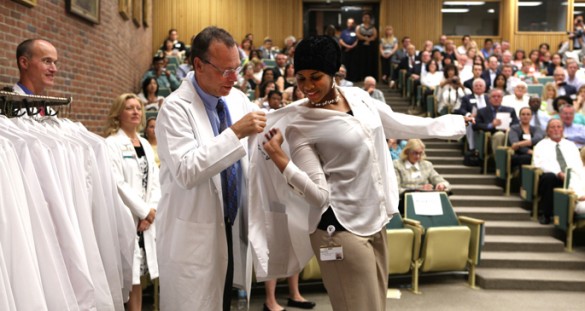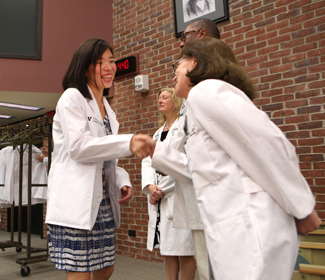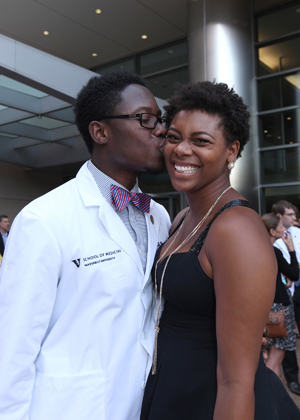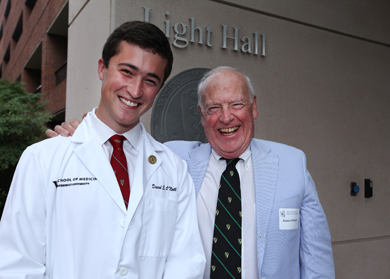
The White Coat Ceremony held at Vanderbilt University School of Medicine that recognizes first-year medical students’ transition from college to professional school serves as a rite of passage and carries a powerful symbolism.
As each student donned the short, white coat, they were also making a fundamental promise to deliver the very best care to every patient, every time, said Bonnie Miller, M.D., associate vice chancellor for Health Affairs and senior associate dean for Health Sciences Education.

“This might seem like a simple enough promise,” Miller told the class of 2018 last week in Light Hall. “But there are a multitude of tasks, tensions, challenges and contradictions embedded in that promise.
“Despite the symbolism, white coats have no magical powers. They will not bestow you with talent nor mystically transform you. The transformation of the coming years will result from your own hard work and your travels alongside the essence of life, illness, love and death.”
Each monogrammed coat contained two envelopes. One was a self-addressed letter written by the student the morning of the ceremony containing a few personal promises for the coming years, about the kinds of people they hope to become as they continue their medical education.

The second contained the name of each student’s white coat sponsor. These generous donors were also recognized during the ceremony.
The official start of the school year began July 21 when students attended their introductory course, Foundations of the Professions.
This weeklong course focuses on the fundamental obligations of medicine and the context in which those obligations are fulfilled.
“Before they receive that white coat, they have a week to think deeply about the reasons that leadership and change are so important for the future of health care,” explained Miller. “They are introduced to the role health care delivery plays in determining and influencing a population’s health.”
This year’s class of 89 new entering students, one of the smallest classes in the school’s recent enrollment, was by design, said Miller.
“We wanted to limit the class size so that we can provide more mentorship in an effort to guide them along a leadership trajectory,” said Miller. “It really does take a village to nurture a leader. Our curriculum is very resource-intensive and we are committed to our leadership mission.”
With more than 6,600 applications for 89 slots, the admissions team, led by Alice Coogan, M.D., and David Bader, Ph.D., had a tough task.

This year’s class has the highest MCAT and grade point average in the history of the school. Students come from 33 states and four countries. There are more than 49 undergraduate colleges and universities represented and 26 majors.
Fourteen of the students plan to pursue M.D./Ph.D. degrees, while 18 students belong to groups that are underrepresented in medicine.
Jeff Balser, M.D., Ph.D., vice chancellor for Health Affairs and dean of the School of Medicine, Miller, Scott Rodgers, M.D., associate dean for Medical Student Affairs, Kim Lomis, M.D., associate dean for Undergraduate Medical Education, and Andre Churchwell, M.D., associate dean for Diversity in Medical Education, assisted each student during the presentation.












